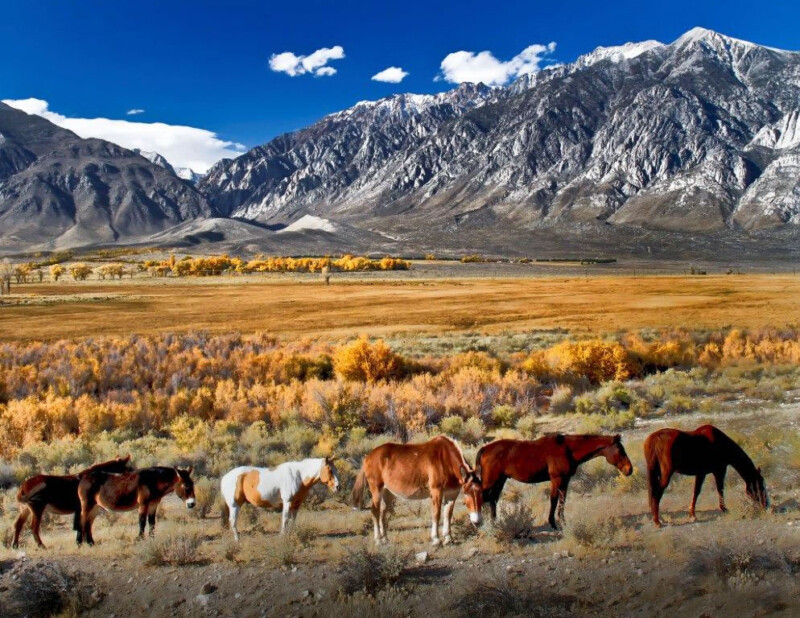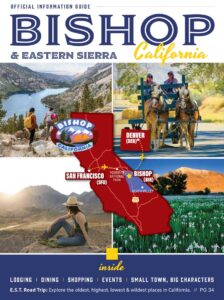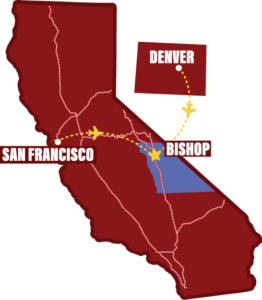How to Pet a Mule (or a burro or a horse)

Drive just about any backroad near Bishop, California, during the winter months, and you’ll see herds of horses and mules out in pasture. Drive that same backroad during the summer, and those pastures are likely to be empty, raising the question, “Where did they go?”
The answer is to be found up in the high Sierra. Aside from the privately owned mules and horses, the vast majority of equines you’ll see in the Owens Valley belong to the eastern Sierra Pack Outfits – locally owned businesses specializing in getting people and their gear into the backcountry for fishing and camping. Come summertime, those cute and friendly mules and horses you stopped to photograph are back at work. It isn’t a bad gig; the typical pack station equine “employee” works about 4 to 5 months out of the year. They work for room and board – but that room and board extends year-round, which is why you see them down in the valley after October.
Horses and mules will be pastured together. You may be more familiar with horses, but mules will quickly win you over, even if you are a little leery of their size and power at first. Mules have large, gorgeous eyes with long lashes and super soft, big ears. Their muzzles are about the silkiest thing you’ll ever lay a hand on, and you’ll soon learn they are playful, inquisitive, and intelligent. Mules have a very distinctive vocal call, and once you’ve heard a plaintive bray, you’ll never forget it. Mules look a lot like horses, but there are some key differences, including their big ears. After a while, you’ll be able to impress your friends with your ability to distinguish one from the other at a glance.
Spend a little time watching them out in pasture, and you’ll be able to pick out the clown or prankster of the herd – the one who’s always in everyone else’s hay or hair. Mules are quite curious by nature and will likely wander over to check you out. It’s fun to test your identification skills – how many horses and how many mules? Girls or boys? Any burros or donkeys? Equines are fed once or twice a day, and when they aren’t eating, they do a stellar job of hanging out and lounging midday. You’re likely to see several laying down, soaking up the sun, and snoozing while others stand watch.
Good equine etiquette is to avoid feeding other people’s animals unless you are invited to. Despite their size and hardiness, mules and horses have fairly limited diets, and offering the wrong treats could result in illness. Additionally, your own fingers might be at risk! If an owner or wrangler is around don’t hesitate to ask for permission, especially if you have a stash of carrots or apples on hand, but also be prepared for a polite “no, thanks”. If you do get the okay, here’s a general rule to follow for safe feeding. Keep your fingers together, place the treat on the palm of your hand, stretch your hand tight, and offer your outstretched palm, letting the horse or mule take the treat from you. Be prepared for a tickle as their whiskers touch your skin!
If you get the go-ahead to touch, a great place to start is on the neck. Rub firmly but gently. Some animals will move away, but some will stay and enjoy your touch. Just like people, some mules are more touchy-feely than others. A friendly mule might move in a little closer for a little more petting – just watch your feet and fingers. Remember, mules weigh any where from 1000 pounds or more – getting a toe stepped on is going to hurt. Another good rule to follow is to never walk behind a mule or horse; they have a blind spot directly behind them and may accidentally kick or startle.
Another treat is to drive out 20 miles east of Big Pine on Hwy 168 to the Piper Mountain Herd Management Area to look for burros. Burros are another equine species – smaller than mules and horses, with big ears and a short mane. Burros were used extensively by early prospectors, as they are hardy, strong, and sure-footed. Read more about the BLM wild horse and burro program here: https://www.blm.gov/programs/wild-horse-and-burro/about-the-program
A great place to get close to mules & burros, and to learn much more about these amazing animals is Bishop Mule Days. Every Memorial Day weekend, Bishop is filled with mules, donkeys, and burros. There are mules jumping, doing dressage, cutting cows, reining, pulling, and racing. There is an incredible parade of mules right down Main Street, Bishop. For ten days you can learn, touch, hear, and smell mules. It really isn’t to be missed – there’s something for everyone from the youngest wrangler wannabe to the senior citizen reminiscing about the good ole days of mining and logging. Find out more about Bishop Mule Days and get your tickets here: https://muledays.org/
After Mule Days, the pack stations begin preparing for their summer seasons, and you can actually ride a mule or horse into the backcountry. Whether you are looking for an hour ride or to spend a few days in the wilderness, the pack stations are your gateway into the mountains via saddle. Watch “A Day in the Life of a Pack Mule”
to get an insider’s glimpse into what you can expect to experience. The backcountry normally starts to open up in June, and pack trips generally are scheduled through September and even later, depending on the weather. Some pack stations offer rides in the off-season, such as this one in the Alabama Hills led by McGee Creek Pack Outfit.
You can find a list of local pack stations here.
And once you’ve fallen in love with that special mule, consider supporting the American Mule Museum here in Bishop, California. You can find out much more about mules and their history in the Sierra, enjoy historic photos and recollections from local mule packers, and understand some of the lingo tossed around the pack stations and Mule Days.
Written by:
Vickie Taton
Since taking a chance summer job in 1980, I've lived in and loved the eastern Sierra. Sometimes home is a place you've never been before, and that is how I felt driving north into Inyo and Mono Counties so many years ago. It really doesn't matter the activity; fishing, hiking, skiing, riding my horse or mountain biking, I love the clean air, the cobalt blue sky, the constantly changing weather. Welcome! I'm happy to share a little piece of this place with you.

